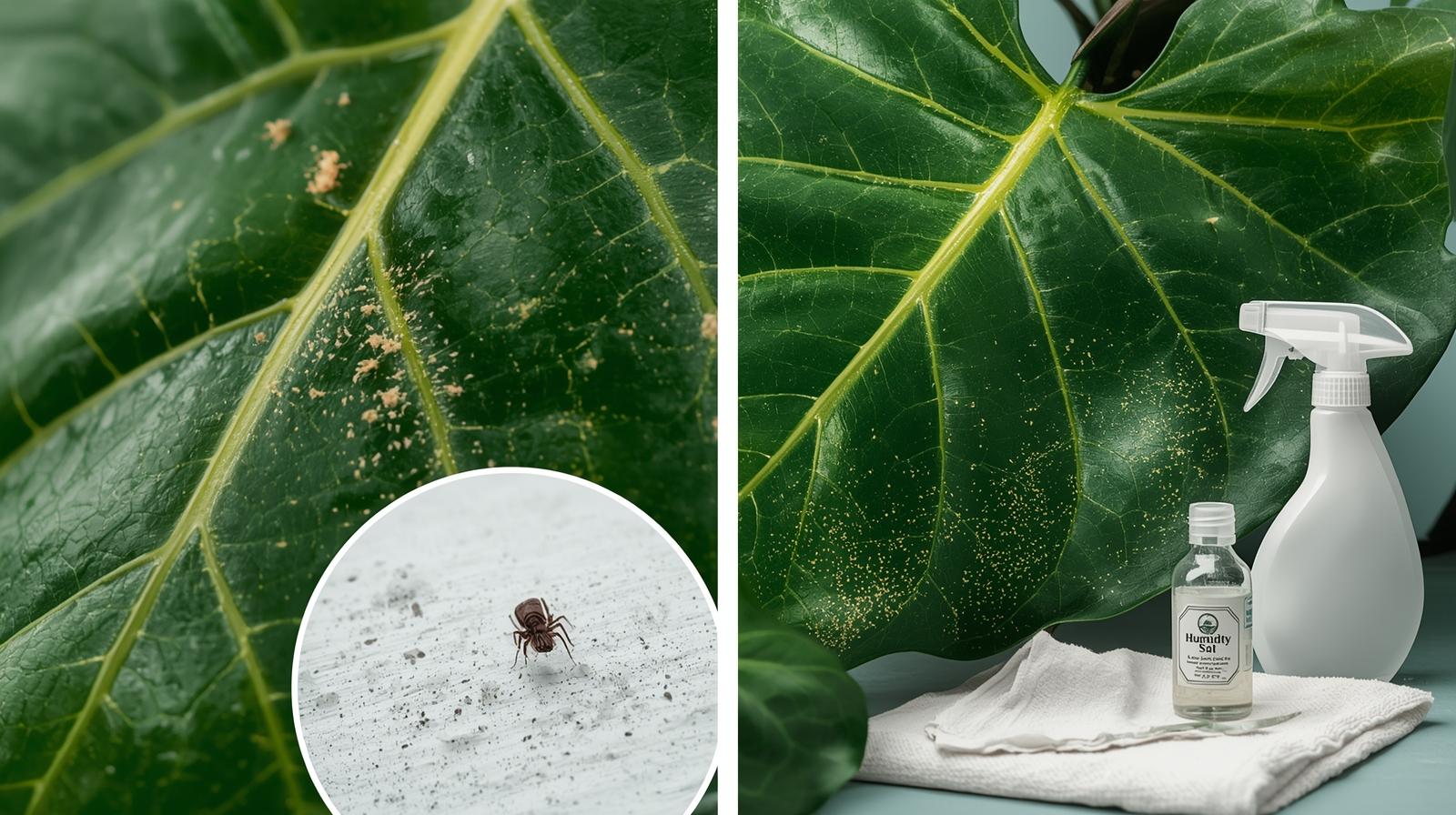That sinking feeling when you notice tiny webs on your beloved fiddle leaf fig isn’t just disappointment—it’s the recognition that spider mites have invaded your plant paradise. These microscopic pests are among the most destructive threats to indoor fiddle leaf figs, capable of transforming a thriving plant into a yellowing, web-covered casualty within weeks if left untreated.
After years of helping plant parents rescue their fiddle leaf figs from spider mite infestations and witnessing both devastating losses and remarkable recoveries, I’ve learned that success depends entirely on early detection, immediate action, and understanding these pests’ behavior patterns.
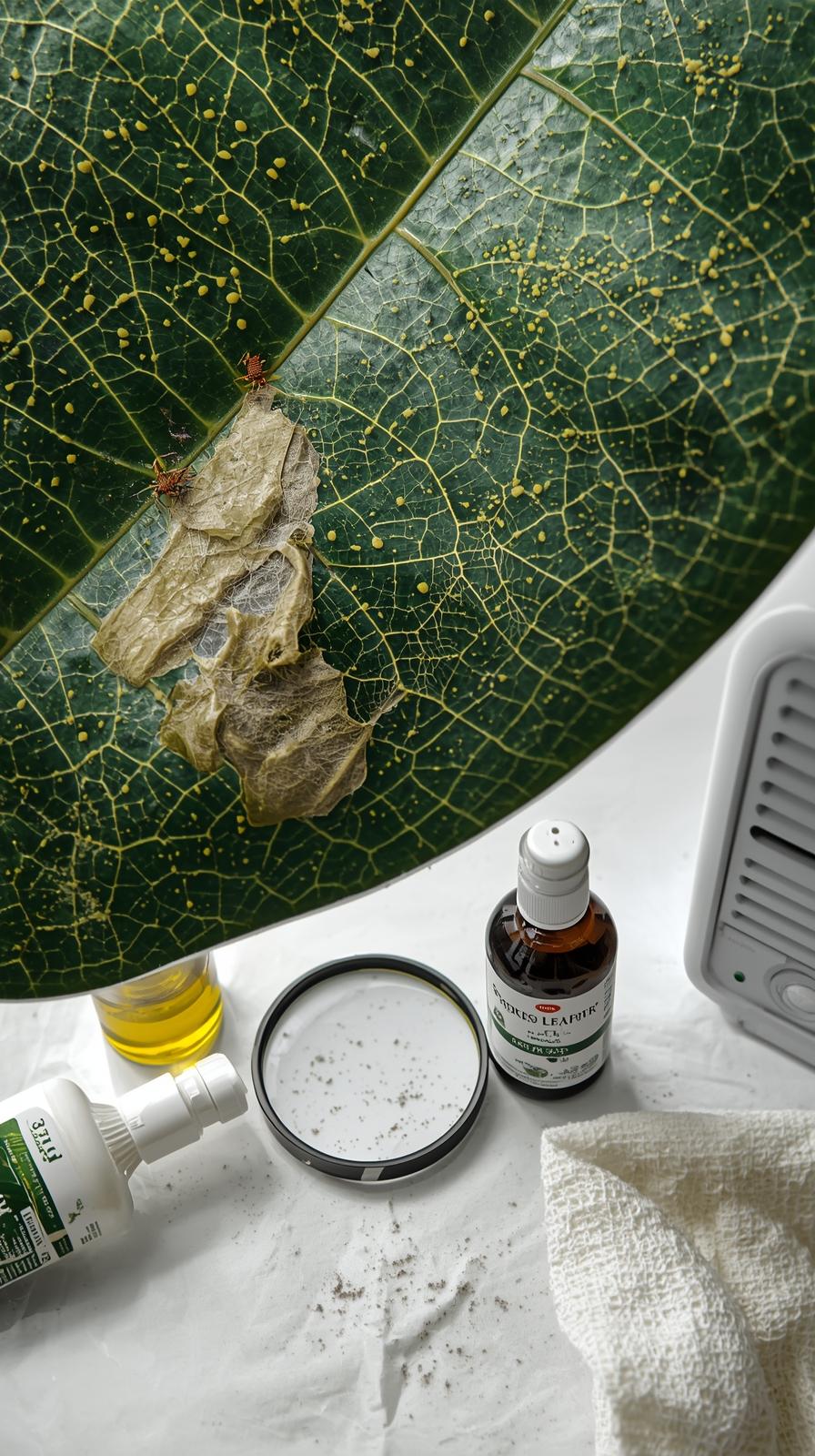
Spider mites thrive in the exact conditions many homes provide—warm temperatures and low humidity—making fiddle leaf figs sitting ducks without proper prevention and treatment strategies.
The good news is that spider mite infestations are completely treatable when caught early and addressed systematically, but the window for easy treatment closes quickly as populations explode exponentially under favorable conditions.
Identifying Spider Mites: Early Detection Saves Plants
Spider mites on fiddle leaf figs often go unnoticed until significant damage has occurred because these pests are nearly invisible to the naked eye. Adult spider mites measure less than 1/50th of an inch, appearing as tiny moving dots on leaf surfaces when viewed closely. The key to early detection lies in recognizing their damage patterns rather than trying to spot the mites themselves.
The first visible sign typically appears as tiny yellow or white stippling on leaf surfaces, particularly concentrated along leaf veins where mites prefer to feed. These stippled areas result from mites puncturing leaf cells to extract chlorophyll, creating a distinctive speckled appearance that distinguishes spider mite damage from other pest issues.
Webbing represents the most obvious spider mite indicator, though it appears only after populations have established significantly. Fine, silky webs initially appear in leaf joints and along stems, gradually spreading across leaf surfaces as infestations intensify. Unlike spider webs, spider mite webs appear dusty and contain tiny moving specks when examined closely.
Leaf color changes progress systematically as spider mite feeding continues. Affected leaves develop a bronze or silvery appearance as chlorophyll destruction advances. Severe infestations cause leaves to yellow completely before browning and dropping, starting with lower leaves and progressing upward through the plant.
The “tap test” provides a reliable diagnostic method for confirming spider mite presence. Hold white paper beneath affected leaves and tap the foliage gently. Spider mites will fall onto the paper as tiny moving dots, confirming active infestation even when webs aren’t yet visible.
Environmental conditions help predict spider mite likelihood. These pests thrive in warm, dry conditions common in heated homes during winter. Indoor humidity below 40% and temperatures above 70°F create ideal conditions for rapid spider mite reproduction that can overwhelm plants quickly.
Understanding Spider Mite Biology and Behavior
Spider mites are arachnids, not insects, which affects both their behavior and treatment requirements. As relatives of spiders and ticks, they respond differently to treatments designed for true insects, making proper identification crucial for effective control strategies.
The life cycle of spider mites accelerates dramatically in warm conditions. From egg to adult takes only 5-7 days at optimal temperatures (80-85°F), allowing populations to explode from manageable levels to plant-threatening numbers within two weeks. This rapid reproduction explains why early intervention proves so critical.
Two-spotted spider mites, the most common species affecting indoor plants, prefer the undersides of leaves where they’re protected from detection and environmental stresses. They feed by inserting needle-like mouthparts into leaf cells, extracting cellular contents that include chlorophyll, proteins, and other vital plant compounds.
Colony establishment follows predictable patterns on fiddle leaf figs. Mites typically begin feeding on lower leaves where conditions remain more stable, gradually moving upward as populations grow. Heavy infestations concentrate in protected areas like leaf joints and along major veins where webbing provides additional shelter.
Dispersal methods help explain how spider mites spread between plants. While they can walk short distances, they primarily spread through “ballooning”—using silk threads to catch air currents that carry them to new host plants. This behavior makes isolation of infected plants crucial for preventing household-wide infestations.
Environmental stress factors make fiddle leaf figs more susceptible to spider mite establishment. Plants experiencing water stress, nutrient deficiencies, or inadequate lighting become more attractive to spider mites and suffer more severe damage when infested.
Immediate Treatment Protocols
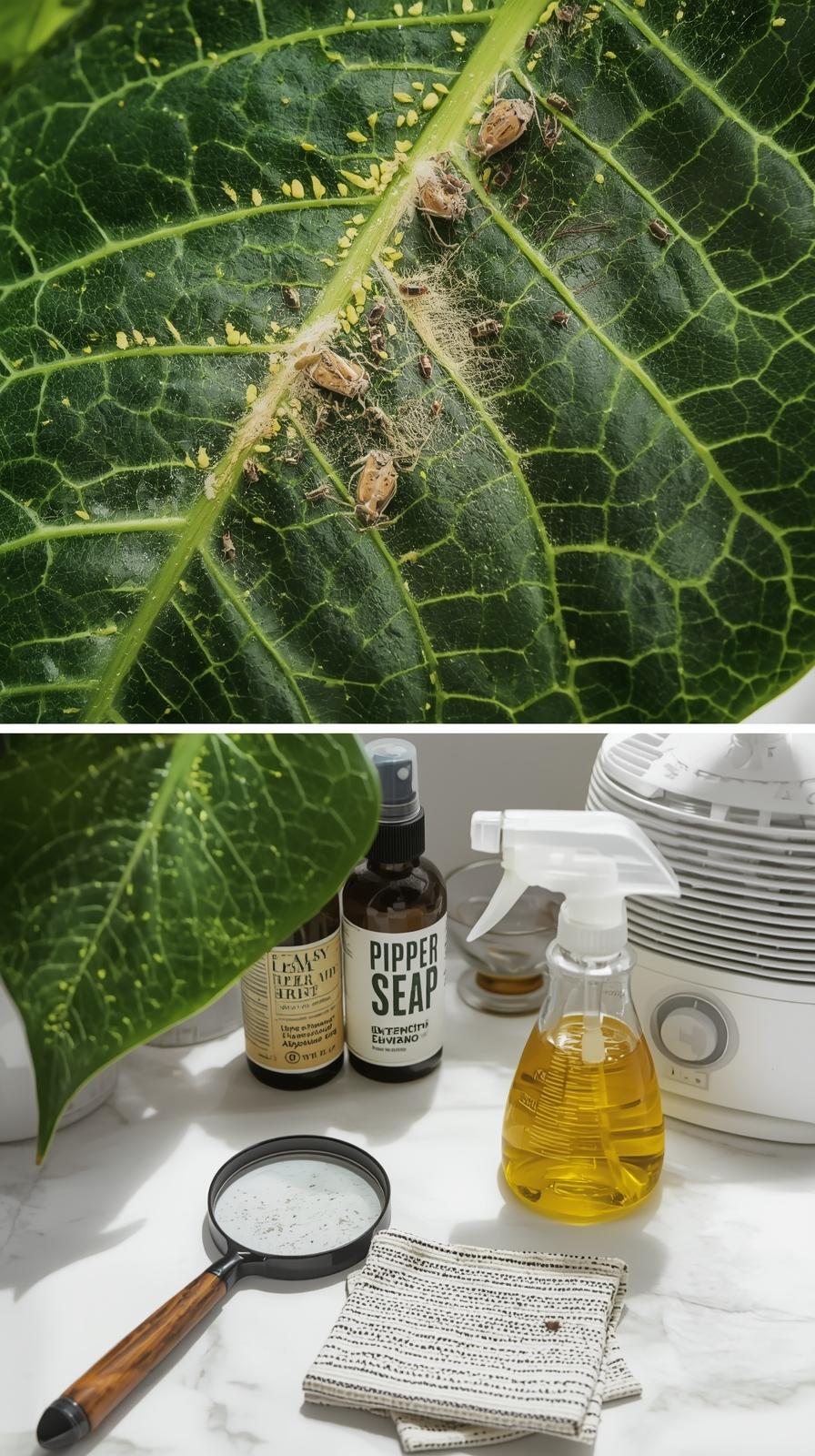
When spider mites are detected, immediate action prevents minor infestations from becoming plant-threatening disasters. The first step involves isolating the affected plant completely from other houseplants to prevent mite dispersal. Move the plant to a separate room or area where treatment can proceed without contaminating nearby plants.
Water treatment provides the safest initial intervention for fiddle leaf figs. Using lukewarm water, thoroughly rinse all leaf surfaces, paying particular attention to undersides where mites concentrate. The water pressure should be firm enough to dislodge mites but gentle enough to avoid damaging leaves. This physical removal reduces mite populations immediately while buying time for more comprehensive treatments.
Insecticidal soap represents the most effective first-line chemical treatment for spider mites on fiddle leaf figs. Mix commercial insecticidal soap according to package directions, or create a homemade solution using 1-2 tablespoons of mild liquid soap per quart of water. Spray all leaf surfaces thoroughly, ensuring complete coverage of undersides where mites hide.
Application technique determines treatment success. Spray during cooler parts of the day to prevent leaf burn, and ensure complete coverage of all plant surfaces including stems and soil surface. Repeat applications every 3-4 days for two weeks to break the mite reproduction cycle and eliminate newly hatched individuals.
Neem oil provides systemic protection that complements contact treatments. Apply neem oil spray weekly as a follow-up to insecticidal soap treatments. Neem oil not only kills existing mites but also disrupts their reproductive cycle and feeding behavior, providing longer-lasting protection than contact sprays alone.
Environmental modification enhances treatment effectiveness significantly. Increase humidity around the treated plant through humidity trays, misting nearby surfaces, or using localized humidifiers. Spider mites struggle in humid conditions, making environmental changes a crucial component of successful treatment programs.
Advanced Treatment Strategies
Alcohol-based treatments offer rapid knockdown of spider mite populations when properly applied. Create a solution of 70% isopropyl alcohol mixed 1:1 with water, adding a few drops of liquid soap to improve coverage. This mixture kills mites on contact but requires careful application to prevent leaf damage.
Test alcohol treatments on a small leaf area first, waiting 24 hours to ensure no damage occurs before treating the entire plant. Some fiddle leaf fig varieties show sensitivity to alcohol solutions, particularly when applied in bright light or warm conditions.
Predatory mite introduction provides biological control for persistent infestations. Phytoseiulus persimilis, a predatory mite species, feeds exclusively on spider mites and can establish populations that provide long-term control. These beneficial mites are available from biological supply companies and work particularly well in greenhouse or enclosed growing situations.
Horticultural oils offer another systemic approach to spider mite control. Light horticultural oils suffocate mites and eggs while being safe for plants when properly applied. Mix according to manufacturer directions and apply during cooler periods to prevent leaf burn.
Rotation of treatment methods prevents spider mites from developing resistance to specific control measures. Alternate between insecticidal soap, neem oil, and horticultural oil applications weekly, ensuring mites cannot adapt to any single treatment approach.
Quarantine protocols should continue for at least one month after the last signs of spider mite activity. Mites can remain dormant in protective webbing or as resistant eggs, emerging weeks after apparent elimination to restart infestations.
Prevention Strategies That Actually Work
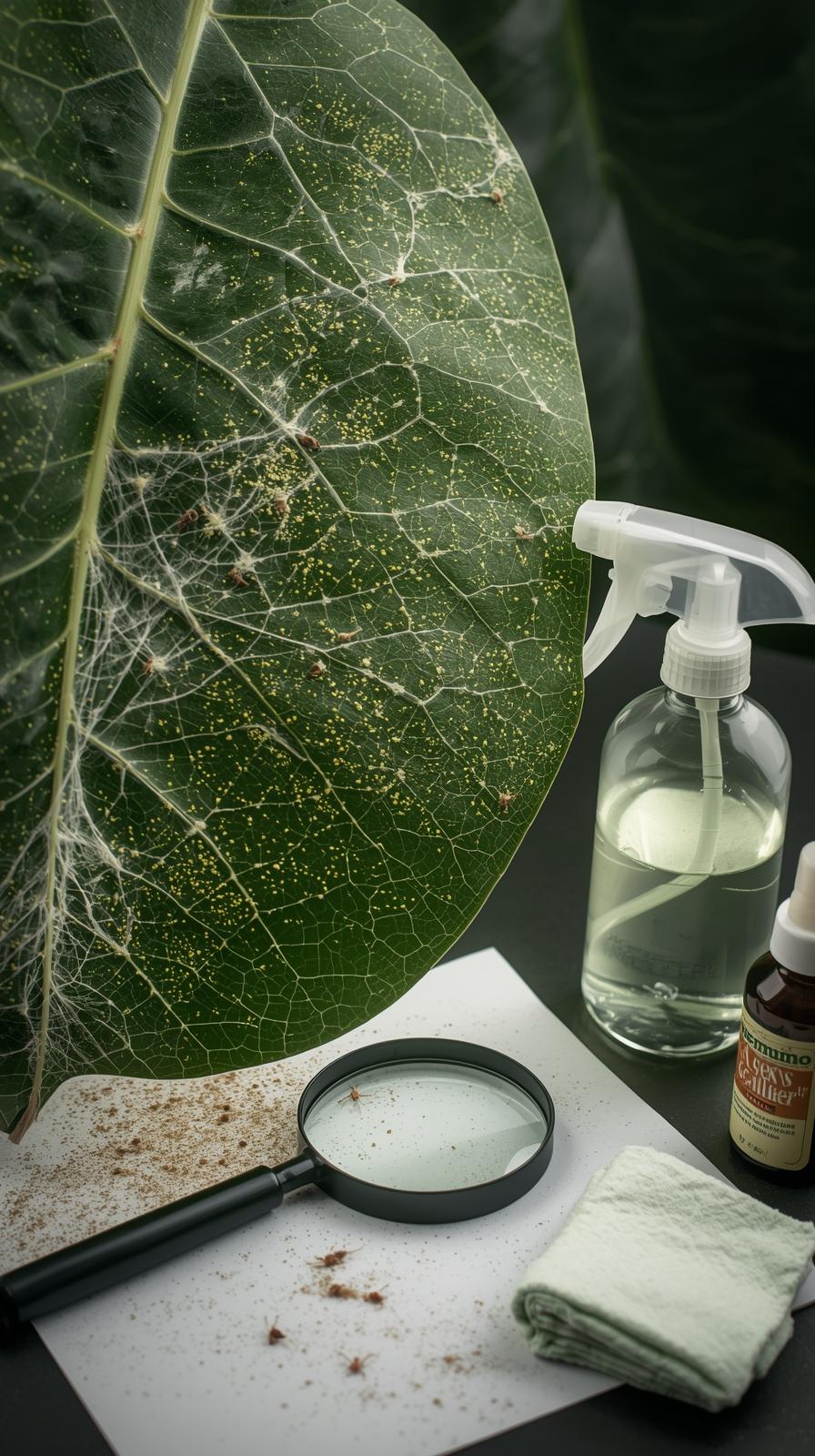
Humidity management represents the most effective long-term prevention strategy for spider mites on fiddle leaf figs. Maintain indoor humidity levels above 50% through grouping plants, using humidity trays, or operating room humidifiers. Spider mites struggle to reproduce in high-humidity environments, making this environmental modification highly effective.
Regular plant inspection catches spider mite problems before they become severe. Check fiddle leaf fig undersides weekly using a magnifying glass or smartphone macro lens. Look for stippling, webbing, or tiny moving specks that indicate early infestations when treatment is most effective.
Air circulation improvements reduce spider mite establishment without creating harmful drafts. Use ceiling fans on low speeds or small circulating fans to maintain gentle air movement around plants. Stagnant air conditions favor spider mite establishment, while moving air disrupts their feeding and reproduction patterns.
Plant spacing prevents spider mite spread between specimens. Maintain adequate space between fiddle leaf figs and other plants to prevent mite dispersal through contact or air currents. Crowded plant arrangements create microclimates that favor spider mite establishment and rapid spread.
Seasonal vigilance intensifies during winter months when indoor heating creates ideal spider mite conditions. Monitor plants more frequently during heating season, and increase humidity management efforts when systems activate. The combination of warm temperatures and dry air during winter creates peak spider mite risk periods.
Quarantine procedures for new plants prevent introduction of spider mites from outside sources. Isolate new plants for 2-3 weeks before introducing them to established collections, monitoring carefully for signs of pest activity during this observation period.
Environmental Controls and Long-Term Management
Temperature management helps create conditions unfavorable for spider mite reproduction. While fiddle leaf figs prefer warm conditions, maintaining temperatures at the lower end of their tolerance range (65-70°F) slows spider mite development without harming plant health.
Lighting optimization can influence spider mite susceptibility. Plants receiving adequate light maintain stronger natural defenses against pest establishment. Supplement natural light during short winter days when spider mite pressure typically peaks.
Soil health affects plant resistance to spider mite damage. Well-fed plants with healthy root systems tolerate mite feeding better and recover more quickly from infestations. Maintain appropriate fertilization schedules and soil moisture levels to support plant vigor.
Water quality considerations become important during treatment periods. Soft water or filtered water prevents mineral buildup that can interfere with spray treatments. Hard water can reduce treatment effectiveness and leave mineral deposits on leaves that create additional plant stress.
Integrated pest management combines multiple approaches for comprehensive spider mite control. Environmental modifications, biological controls, and targeted chemical treatments work together more effectively than any single approach alone.
Monitoring systems help track treatment progress and early detection of recurring problems. Keep detailed records of inspection dates, treatment applications, and environmental conditions to identify patterns and optimize management strategies over time.
Recovery and Plant Rehabilitation
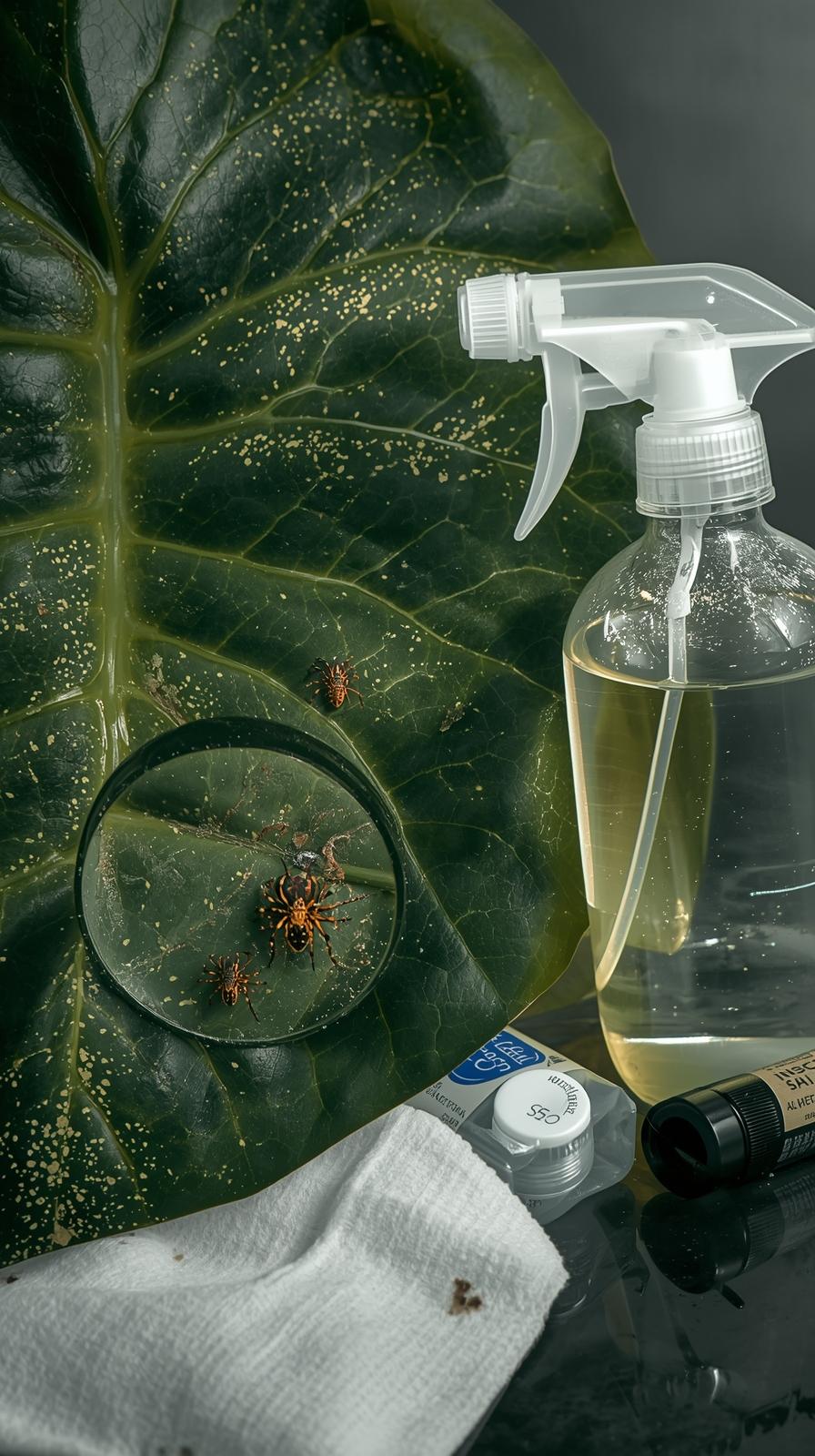
Damaged leaf management requires careful consideration during recovery periods. Remove severely damaged leaves that show extensive browning or yellowing, but preserve leaves with minor stippling that can still contribute to plant health. Over-pruning weakens plants and slows recovery.
Nutritional support helps plants recover from spider mite damage more quickly. Provide balanced, diluted fertilizer every 3-4 weeks during recovery, avoiding high-nitrogen formulations that can stimulate tender growth attractive to remaining mites.
Growth pattern monitoring reveals recovery progress and helps identify ongoing problems. New growth should appear healthy and unstippled within 4-6 weeks of successful treatment. Continued stippling in new leaves indicates incomplete mite elimination requiring additional treatment.
Patience during recovery prevents premature declaration of treatment success. Complete recovery from moderate spider mite infestations takes 2-3 months as damaged leaves are replaced by new, healthy growth. Rushing the process or discontinuing preventive measures too early often leads to re-infestation.
Long-term vigilance maintains spider mite-free conditions. Continue weekly inspections and environmental management indefinitely, as spider mites can reestablish from microscopic populations or reintroduction from outside sources.
Success indicators include absence of new stippling, no visible webbing, healthy new growth, and stable environmental conditions that discourage spider mite establishment. These positive signs confirm effective treatment and successful prevention strategies.
Spider mite infestations on fiddle leaf figs represent serious but entirely manageable threats when approached with proper knowledge, quick action, and comprehensive treatment strategies. The key lies in understanding that spider mites are preventable through environmental management, detectable through regular inspection, and treatable through systematic application of appropriate control measures.
Success requires viewing spider mite management as an ongoing process rather than a one-time treatment, with prevention strategies that create unfavorable conditions for mite establishment while maintaining optimal growing conditions for your fiddle leaf fig. With proper attention to humidity, regular monitoring, and immediate response to early signs of infestation, spider mites need never become the devastating problem that destroys otherwise healthy plants.

